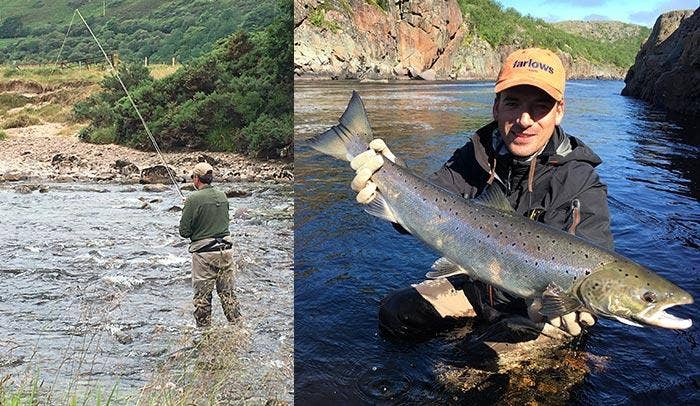With salmon now beginning to build in numbers in our pools after an encouraging 2020 season on many UK and Irish rivers, now is a great time to experiment with fishing ‘The Hitch’, also widely-known as the ‘Riffling Hitch’.
Hopefully this short guide will explain this salmon fly fishing technique and inspire you to try it next time you’re on the river. When it all goes to plan, there are few things in salmon fishing quite so exciting!
What is 'The Hitch'?
In simple terms, fishing the hitch for salmon means skating your fly on the surface, using your fly or tube to create a V-shaped ‘wake’ to entice fish to attack.Essentially, rather than thinking in terms of getting the fly down to the level of the fish with weighted tubes or sink tips, instead the aim is to ‘raise’ fish up from their lies. It’s a method that has been long-practiced on small highland spate rivers, but it works equally well on larger rivers when conditions are right. It’s also a method that is now synonymous with salmon fishing in the clear waters of Iceland. Indeed, from eastern Canada to Norway and Russia, the method has been adapted and developed and it now exists in many forms.
So, why does it work so well in certain locations and at certain times but not in other scenarios? In this brief guide, I aim to demystify the art of fishing the hitch and equip you with a checklist of conditions to look out for.
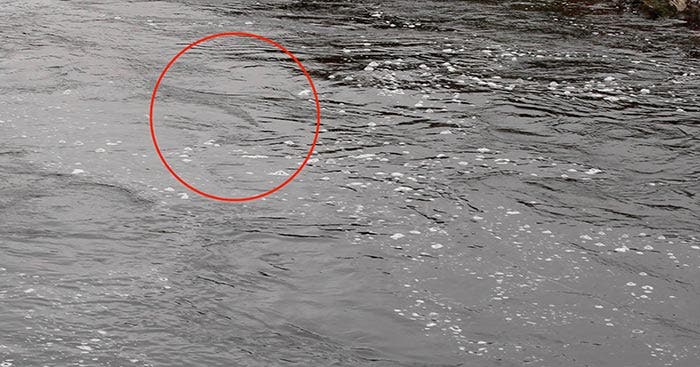 The subtle 'V'-shaped wake you should be aiming for
The subtle 'V'-shaped wake you should be aiming forWhen to fish The Hitch - A 5-step checklist
As with all things salmon fishing, there are never hard-and-fast rules, but when it comes to fishing the hitch there are certain factors that must be in place before I’d recommend giving it a concerted effort. Here are the things I look out for…1. Fish holding in the pool
Fish the hitch when you’re confident that the pools you are fishing are either holding resident fish, or fish which have stopped briefly during their upstream migration. This means that you should concentrate your hitching effort on ‘holding pools’ where fish will have time to see your fly gliding above them.Remember we’re trying to instigate an aggressive reaction and fish that are running hard upriver, heads down, aren’t likely to stray from their primary mission. If you’re faced with a fast run without many fish-holding features, leave the hitch flies in your box and swing something conventional through at mid-stream.
Are you seeing resident fish splashing about below you and fresh fish entering the pool? Perfect! It’s hitching time…
2. Pace of water/water level
Experienced hitchers will know from looking at a pool whether it feels right for the hitch or not, but less-experienced anglers may struggle to see the signs of a ‘hitchy’ looking spot. Bearing in mind that the aim is for the fly to create a visible ‘V’-shaped wake on the surface, you need an area of water with just the right amount of pace and surface tension to allow it to work effectively.Rough and fast water at the neck of a pool is seldom the best place to fish the hitch, but main pool bodies, and especially tails, where the water seems to glide away will allow the method to work better. A small, subtle ripple on the surface is ideal - enough to disguise your line and leader, but not so much that your wake gets lost in the current. You want your wake to stand out from the current without being too ‘loud’.
 Classic 'glidey' water towards the tail of a pool - perfect for the hitch
Classic 'glidey' water towards the tail of a pool - perfect for the hitch3. Water clarity
This is a crucial element, and the reason why the method works particularly well in the gin-clear waters of Iceland. Here in the UK we often find the water resembles whisky, rather than gin, due to our peaty soils, but the hitch can still work very well in peat-stained water.The crucial factor is visibility as salmon need to be able to see the wake we’re creating on the surface. Cloudy or dirty water? Forget it. Visibility of a few feet or more is what you are looking for.
4. Water temperature
As important as water clarity is water temperature. You need fish to be comfortable moving between layers in the river to rise up and attack the fly - remember that different depths in the river have temperature variations. It’s for this reason that the method rarely works well in the chilly temperatures of early spring, your chances may also be negatively impacted at any time in the season by a cold wind that chills the surface layer.Once water temperatures reach the magic mid-50s Fahrenheit or 12-13 Celsius, you’re in business. Do be aware that salmon can go off the take when temperatures start to creep towards 20C, but there is a window of hitching opportunity from 12C into the mid-teens.
Again, there are exceptions to the rule, but use these parameters as a guide!
5. Light level
It’s been said many times before - salmon don’t have eyelids, so trying to raise them to the surface on a bright, hot, cloudless summer’s day when the sun’s rays are pointing straight down the pool is probably not going to be the best time to try the hitch. Overcast, dull grey skies are ideal. If you’re stuck with bright sunny conditions, consider fishing deeper during the middle of the day and try the hitch early in the morning and late evening when the sun is lower in the sky.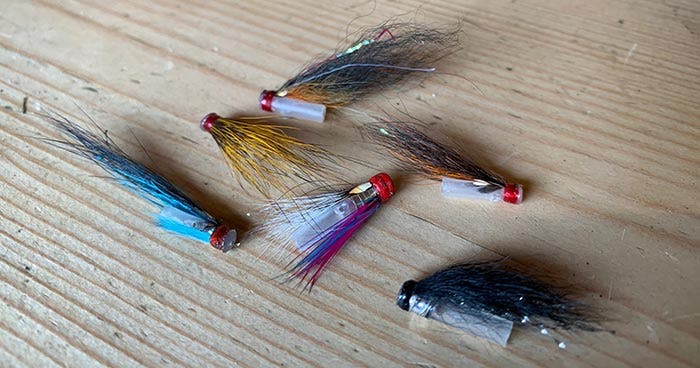 A selection of small hitch tubes
A selection of small hitch tubesHow to Fish the Hitch
It’s possible to hitch both dressed flies and tubes, though it’s probably fair to say that these days the availability of specialist micro tubes means more of us go down the tube route.The Riffling Hitch knot
If you want to fish a small dressed fly, you’ll need to master the riffling hitch knot to ensure it skates properly on the surface, and this is a simple process:First, tie on your fly as you normally would with your preferred knot. For most ‘up-eye’ salmon flies a turle or double-turle works best.
Next, tie two half hitches over the head of the fly behind your main knot. You’ll notice that this pulls the leader out at an angle - perfect. Carefully position these half hitches on either the left or right hand side of the fly’s head depending on the bank you are fishing on. To check that you’ve got it right, your knot should be positioned on the side of the fly that is closest to you as it swings downstream.
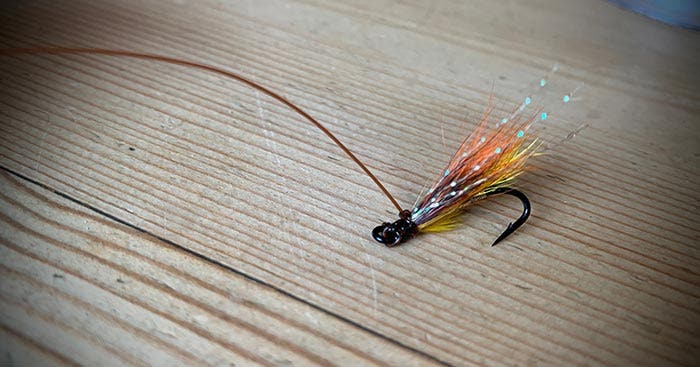 Leader at a right angle when hitching a dressed fly
Leader at a right angle when hitching a dressed flyEasier still are the array of specialist hitch tubes now available to buy. These small plastic tubes come with ready-made hitch holes on either side of the tube body. Instead of threading your leader through the main eye of the tube, simply insert your leader through one of the side holes and then out the rear before tying your hook on. Which hole you use, left or right side, again depends on which bank you are fishing on. Remember to use the hole on the side of the tube which is closest to you as it swings downstream.
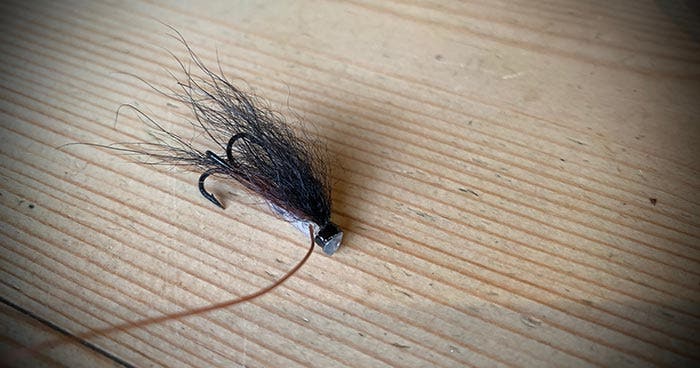 Pass the leader through one of the side holes
Pass the leader through one of the side holesLeader choice
This is personal preference but I’ve found that monofilament leader, especially Maxima, makes fishing the hitch much easier as it it sits higher in the water and doesn‘t drag your fly down. Use a long leader, around 12ft, to maximise the distance between your fly presentation and any disturbance caused by your fly line.Hook choice
Light, strong hooks are the order of the day here. You can use singles, doubles, or trebles but the most important thing is to ensure that the added weight of your hook doesn’t sink your fly. For this reason we mostly use hooks in small sizes, 12-14 and sometimes smaller.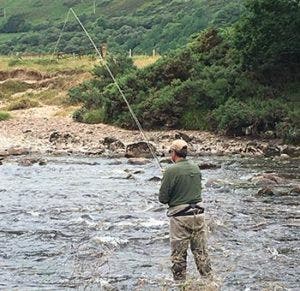 Use a high rod angle if necessary to get your fly waking properly
Use a high rod angle if necessary to get your fly waking properlyHigh-stick
Don’t be afraid to fish the hitch with a very high rod angle. It may feel strange for those used to swinging flies with a low fly rod, but sometimes the extra height can really help to get your fly skating properly.Light drag
A high rod angle and tight drag is a recipe for disaster. Any taking fish will want to turn back down with the fly, so loosen off your drag for the initial take. You can adjust again during the fight.Smooth and steady retrieve
In my experience, salmon like a hitch fly that is fished in a smooth and steady pace across the pool. A retrieve which is too fast or too jerky just doesn’t seem to work nearly as well. Use long, smooth draws to get the fly moving steadily and, during the swing, slowly move your rod towards the bank you are fishing on to help create the right pace.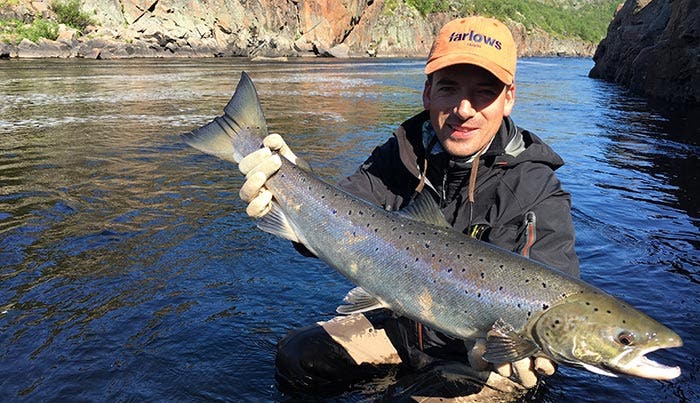 A fish taken on the hitch from the Kharlovka river in Russia. Note the 'glidey' glassy water in the background - a good place to try the hitch
A fish taken on the hitch from the Kharlovka river in Russia. Note the 'glidey' glassy water in the background - a good place to try the hitchThings You'll Need
If you’re inspired to give this technique a go, consider stocking up with some of the following items:- Hitch Tube Fly Silver Stoat
- Hitch Tube Fly Cascade
- Mini Hitch Tube Fly Sunray
- Mikael Frodin's '8 Great Flies for the Surface'
- Maxima Tippet
- Patriot Nordic Tube Single Hooks
- Loop Double Tube Hooks
- Fulling Mill Micro Treble Hooks
Tight lines!

